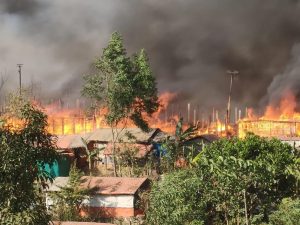Another fire swept through a refugee camp housing Rohingya refugees in Bangladesh yesterday, killing a six-year-old boy and leaving about 2,000 people homeless, including 1,000 children, highlighting once again the unsafe and insecure conditions in the camps.
In a statement yesterday, the international non-government organization Save the Children, which has an active presence in the camps, said that the blaze destroyed a part of Kutupalong camp in Cox’s Bazar at around 4.30 p.m. local time yesterday afternoon, destroying 400 shelters.
This is the sixth fire this year to tear through the Rohingya refugee camps in Bangladesh, Save the Children said. In January, a massive conflagration in Kutupalong destroyed 1,200 shelters and left more than 5,000 people homeless. Four other smaller fires have occurred since then.
The latest blaze points once again to the profoundly unsafe nature of the camps in Cox’s Bazar, which house around 1 million mostly Muslim Rohingya, many of whom were driven out of Myanmar’s Rakhine State by the military in savage assaults in the second half of 2017. (Kutupalong, the world’s largest refugee camp, alone houses around 900,000 people.)
As the United Nations refugee agency noted in an operational update in January, “fires in the Rohingya refugee camps are particularly severe due to overcrowding, poor infrastructure and use of flammable materials for shelters (bamboo and tarpaulin),” adding that the risk of fires was higher during the dry season between October and June. Save the Children cited the Inter Sector Coordination Group Daily Incident Reporting to the effect that there were over 150 fires reported in the camps in 2021, “a staggering 180 per cent increase on the 84 fires seen in 2020.”
Onno van Manen, STC’s country director in Bangladesh, said in the statement that “More fire-resistant materials must be permitted and additional openings in the fencing need to be built so that refugees can reach safety in an emergency.”
Residents of the sprawling settlements in Cox’s Bazar also face an uncertain security situation, in which some residents report being menaced by militants belonging to outfits such as the Arakan Rohingya Salvation Army (ARSA), whose pin-prick attacks provided the casus belli for the Myanmar military’s assaults in 2017. In September, Mohibullah, a prominent Rohingya activist, was shot dead at close range by gunmen at his office in Kutupalong refugee camp, allegedly by ARSA assailants.
Mohibulla’s killing then prompted a crackdown by Bangladeshi authorities, which residents allege has widespread abuses of power, including blackmail, extortion, violence, and even sexual assault.
All this is a reminder of the size of the humanitarian emergency that was unleashed by the Myanmar military in 2017, and which continues to fester in southeastern Bangladesh. The mutually agreed goal of repatriating Rohingya to their former villages in western Rakhine State – always a tall order given the active conflict between the Arakan Army (AA) and the Myanmar military, and the inhospitable political conditions there – has grown vastly more complicated since the military’s seizure of power in February of last year.
While Rakhine State has been relatively untouched by the post-coup violence that has erupted in other parts of the country – a by-product of a ceasefire between the AA and the Myanmar military just prior to the coup – the army’s takeover and its urgent concatenation of economic, political, and humanitarian crises has pushed the Rohingya refugee crisis down the agenda, more or less freezing the repatriation push. In this context, about the best that can be hoped for is that the camps can be developed into safe, secure homes for the hundreds of thousands that for now, and probably for some time to come, call their home.

































